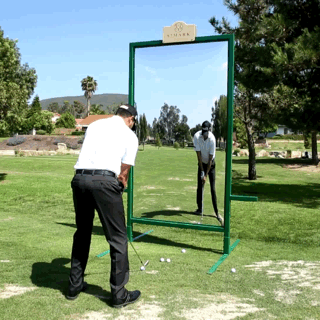- John Dunigan
5 Steps to Making a Swing Change

By now, you might have had enough of missing golf shots in your usual way, and you may be considering making a swing change to eliminate the flaw that causes that miss. It is my standard practice to let my students know the process of learning a new move and taking it to the course, because, quite often, golfers approach learning in a way that doesn’t help the process.
The 5 Steps are as follows:
1 Do it right on the range!
2 Do it right on the range with a target.
3 Do it right on the course.
4 Do it right on the course with a scorecard.
5 Do it right on the course with scorecard when the heat is on.
Let me explain.
Step 1
The world is full of good practice swings! Have you ever seen an avid golfer with an un-golf-like practice swing? Of course not! But put a ball in the way, and what often happens? A totally different swing. This golfer has not yet learned to make the swing with a ball in the way. Disaster! Folks, you can’t let yourself get outsmarted by a 1.68 ounce piece of plastic! If you have to tee the ball up and /or swing more slowly at first, then that’s what you have to do, but do it right! You can gradually increase the speed as you learn the feel. Truly, it’s not so easy to split your concentration between the move and trying to make contact with the ball, so do it right until you can find the ball with the right move! Don’t worry about where the ball goes yet. Just make sure you do it right despite the ball.
By the way, you should only incorporate ONE new move into your swing at a time. There is a hierarchy and prioritization of critical motion, and we should always pick the first, biggest error that needs correction and get that out of the way asap. Trying to change more than one move at a time will likely be a disaster. By the way, address position and setup stuff doesn’t count as a move. You get all day to set up properly!
Step 2
Many golfers add the target too soon, and become distracted from their purpose, which was to make the new move. They earnestly try to make the new move, but when the ball doesn’t go to the target, they quickly shift their attention to where the ball is going (or not going) and their awareness of the move disappears. This is how to make a bad move stick forever! To pass Step 2, you have to create a dual focus during the motion—a feel of the move combined with a mind’s eye picture of the target. On this step, you’ll have to figure out how to control the face and maybe the path to get the ball to the target-using the new move.
Step 3
Now you are ready to transfer your new move to the course. Hold off on the scorecard for now and practice Step 2 on the course. I call it scrimmaging your new move. Golf is the only sport where we practice away from the field of play and never scrimmage our plays under real conditions. That’s just silly. Go out on the course and give yourself mulligans and make yourself do it right while on the course with a target and hazards and such.
Step 4
Now we add the scorecard and make it count. I know all about “the zone.” I know all about paralysis by analysis. I also know that if you always let yourself revert to your old stuff when it counts, you’ll never make the changes you need to reach the next level of ball control skill. Lot’s of discipline is necessary here in Step 4. You are learning to trust your swing now!
Step 5
Once you’ve gotten past Step 4, you’ve nearly got it made. Now you have to continue to use your new move under pressure—in a match or tournament when the heat is on. Of course, you will need to continue this process until the flaw is eliminated permanently. When you do it right without trying to, it has been learned. Until that point, you’ll have to make it happen.
Years ago, I spent two days with Ivan Lendl, the #1 tennis player in the world 270 weeks in the 80’s, who described this exact process in learning a topspin backhand, taking it from a liability to a strength in his quest to be the best. It’s a simple process, but as I said, it takes quite a bit of discipline to go through it. Keep in mind that you should never make a swing change because of looks. Only make a change when you know that a particular part of your motion is causing the ball control problem you are experiencing.















